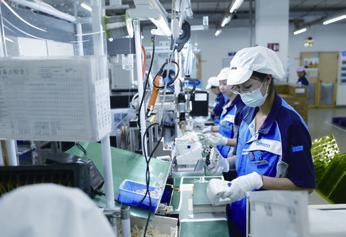A‘Gold Mine’for Foreign Investors

In 2019, expanding foreign investment infl ow was one of the bright spots in the Chinese economy, revealing that the country remains a major magnet for worldwide investors.
Since the beginning of that year, China maintained a stable and upward trend in attracting foreign capital with more major foreign-invested projects worth billions or even tens of billions of dollars, said Meng Wei, spokesperson for the National Development and Reform Commission, on December 17, 2019.
Just a day later, 128 deals with a combined investment of over 560 billion yuan($80 billion) were signed at a global investment promotion conference in Shenzhen in the southern province of Guangdong, signaling an upbeat outlook on the development of the booming technology hub and China as a whole.
Amid weak global demand, foreign direct investment (FDI) into the Chinese mainland expanded 6 percent year on year to 845.9 billion yuan ($124.4 billion) in the fi rst 11 months of 2019, according to data from the Ministry of Commerce.
Of the total, 28.5 percent, or 240.7 billion yuan ($34.42 billion), went to hitech industries, surging 27.6 percent year on year. During the same period, a total of 36,747 new foreign-funded enterprises were established.
Citing German chemical giant BASFs smart Verbund project in Guangdong and U.S. electric carmaker Teslas Shanghai gigafactory, Meng said the progress of these large projects demonstrated these firmsconfi dence in investing in China.
Amid overall FDI growth, overseas retailers and financial investors were also navigating their strategies to tap into the market potential of the second largest economy.
In 2019, a slew of international companies including Adidas, Nike and Lego opened new flagship stores in major Chinese cities, while German supermarket chain ALDI entered the Chinese mainland market and Lawson convenience stores swept across small cities and towns.
Meanwhile, Walmart China announced plans to accelerate its expansion by opening more than 500 new stores and depots in the next fi ve to seven years and updating 200 existing stores over the next three years.
Similar momentum took place in the financial market. By the end of October 2019, foreign banks had established 41 legal-person banks, 114 branches and 976 operating institutions in the Chinese main- land, with aggregate assets topping 3.37 trillion yuan ($482 billion).
In the wake of the scrapping of investment quota limits for the Qualified Foreign Institutional Investor and Renminbi Qualified Foreign Institutional Investor schemes, overseas institutions have shown growing enthusiasm to buy more.
Bonds and stocks owned by overseas investors were valued at 2.18 trillion yuan($311.7 billion) and 1.77 trillion yuan($253.1 billion), respectively, both notching up to historical highs by the end of the third quarter of 2019.
While newcomers are rushing in, China has been honoring its commitment to opening up more sectors for foreign investment. To ensure the implementation of the Foreign Investment Law on January 1, 2020, the State Council, the cabinet, approved a draft regulation in December 2019, promising equal treatment of domestic and foreign businesses regarding government funding, land supply, and tax and fee cuts. The move came after cuts in the number of sectors and businesses that are off-limits to both domestic and foreign investors on the negative list for market access issued in November 2019.
While charting the course for economic work in the new year, the Central Economic Work Conference in December 2019 vowed to further facilitate and protect foreign investment as opening up continues to develop on a larger scale and at a deeper level.
With the implementation of these measures, there will be more foreign-funded projects in China as foreign investment sees an optimized environment, Meng said.

